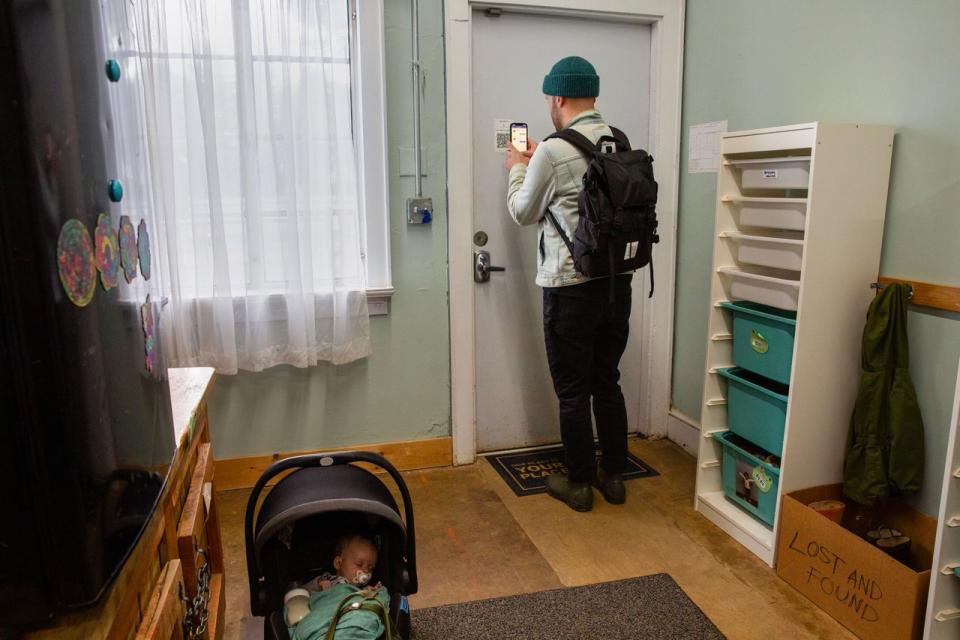What One Employer Found When It Started Providing Child Care
Zach Wiley left his job at a coffee roastery in rural Virginia in 2021 because he found the 45-minute commute from Roanoke too onerous.
Most Read from The Wall Street Journal
Less than a year later he returned to his former employer, this time moving his family into a house they bought in the neighborhood. What helped? The employer, Red Rooster Coffee, offered subsidized on-site child care.
“The child care is just huge. I don’t know what we would do without it,” said the 31-year-old, who pays $2 an hour each for his toddler son and infant daughter’s daycare. “Our son loves it, and I never worry about him. He’s right through the next door.”
Red Rooster Coffee is among a growing number of businesses in high-turnover industries that are turning to child care as a solution for staffing problems.
Restaurants, warehouse operators and manufacturers are stepping up subsidies for employees, contracting with backup-care providers and finding ways to bring care close to employees. Executives see it as a way to reduce churn because the cost of searching for and retraining replacements has skyrocketed.
In 2023, 32% of companies surveyed said they offered backup child care, up from 26% in 2019, according to an employee-benefits survey of 4,217 companies conducted by the Society for Human Resource Management.

Child care is an issue that has vexed American workers since women entered the labor force in large numbers in the second half of the 20th century. Disruptions to staffing because of child-care concerns have long been a problem for employers, and those issues have worsened since the Covid-19 pandemic.
The labor-force participation rate—the share of Americans working or looking for a job—was 62.7% in March, 0.6 percentage point below the February 2020 prepandemic level. Businesses have raised wages to attract workers—more steeply for blue-collar workers than the broader labor force. Still, progress on drawing more people back into the workforce has been slow.
During the pandemic, delivery company United Parcel Service began offering backup child-care services to about 300 employees working evening shifts in a sorting facility in Lathrop, Calif. The company, which has 414,000 employees in the U.S., said it has expanded the program to two other facilities in Ohio and Pennsylvania.
When the family member who normally looks after her daughter fell sick, Danielle McQueen took her then-8-year-old to backup care. Otherwise, McQueen—who works evenings at Lathrop auditing parcel sizes—would have missed work for nearly a week.
“It is a plus. It’s a little incentive to stay at the job,” the 34-year-old said.
UPS executives said the benefit has reduced absenteeism and helped lower the employee turnover rate.
“We were having absences from parents who were kind of embarrassed because of the stigma,” said Danelle McCusker, president of UPS’s human-resources group.
Some businesses may bristle at the price of subsidizing care for employees, and offering on-site care comes with its own costs and challenges, including those associated with licensing and finding staff. Companies with a workforce spread across the country also have to grapple with a patchwork of state and local regulations governing employer-provided child care.

Many developed economies subsidize child care, unlike in the U.S., where the issue is largely left in the hands of employees and, increasingly, businesses. The U.S. contributed $900 per toddler toward care in 2019, according to the Organization for Economic Cooperation and Development, the last year for which data is available. That compares with $9,000 in France and $16,100 in Sweden.
“The federal government is making this your problem by failing to make the investment it should be making,” said Kathryn Anne Edwards, an economist and independent policy consultant who specializes in child care.
The Biden administration wants semiconductor businesses applying for federal loans under the Chips Act to outline plans for providing workers with affordable child care. The administration has also called for boosting federal funding to expand access to free preschool.
Red Rooster Coffee began offering subsidized child care in 2018, when the company moved to an 11,000-square-foot facility in Floyd, Va., and owner Haden Polseno-Hensley had to decide how to use the new space.
“More of our employees started getting pregnant or having spouses about to have a baby,” said Polseno-Hensley, at the time the father of a young child.
As a result, he set up an on-site child-care facility. Locals can also use the daycare, at rates that aren’t subsidized.
Red Rooster hired a former teacher to run the daycare center and fulfill the licensing and inspection requirements. Still, Red Rooster subsidizes 70% of the cost of running the facility. “It’s basically an investment in our staff by the coffee-roasting company,” said Polseno-Hensley. Most employees have used the facility at one time or another, he said.

Employers including retailer Home Depot, outdoor outfitter Patagonia and hotel chain Marriott have on-site child care services at their headquarters, but the benefit remains limited across the U.S. In 2023, 12% of U.S. workers had access to child-care benefits, up from 10% a decade earlier, according to the Labor Department. Those figures reflect reimbursements for employees who pay for daycare or a babysitter for their children.
Many economists and employers contend that the high cost of child care is part of the reason workers are staying on the sidelines. The average child-care payment per household has risen over 30% since 2019, according to Bank of America Institute. Parents of children aged 14 or younger are spending roughly a quarter of their income on child care, and a third of parents dip into savings to pay for child care, said a recent survey by Care.com.
Write to Harriet Torry at harriet.torry@wsj.com and Esther Fung at esther.fung@wsj.com
